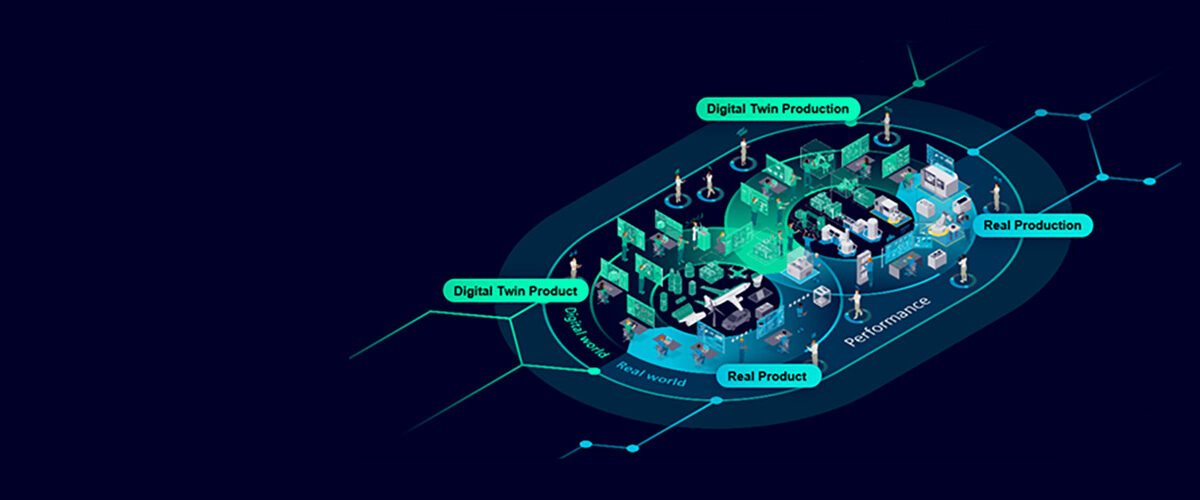
Enable Actionable Insights and Informed Decisions With Closed-Loop Connections Between the Digital and Real Worlds Across the Value Chain
What is Digital Twin Technology and Where Do We Start?
Blog Article | November 14, 2023
A digital twin is a virtual or digital representation of a physical object, system, or process. Here are some key characteristics and components of a digital twin:
1
Data Integration
Digital threads involve integrating data from various sources and systems, including CAD (Computer-Aided Design) models, PLM (Product Lifecycle Management) software, ERP (Enterprise Resource Planning) systems, IoT (Internet of Things) sensors, and more.
2
Interoperability
Systems and tools used throughout the product lifecycle should be able to communicate and share data seamlessly to maintain continuity.
3
Traceability
A digital thread enables the tracking and tracing of components, processes, and changes, making it possible to identify the history and status of a product at any point in its lifecycle.
4
Collaboration
Digital threads facilitate collaboration among different teams and departments by providing a common platform for sharing information, which can improve decision-making and problem-solving.
5
Real-time Updates
In some applications, digital threads offer real-time or near-real-time updates, allowing stakeholders to monitor and respond to changes quickly.
6
Improved Efficiency
By streamlining data management and reducing manual data entry and paperwork, digital threads can lead to increased efficiency, reduced errors, and cost savings.
7
Data Analytics
Digital threads provide a wealth of data that can be analyzed to gain insights into product performance, identify areas for improvement, and optimize processes.
Connect with a Saratech Digital Transformation Specialist
to review your business needs, discuss capabilities, cost and implementation road map, and review Siemens Digital Twin solutions.
Do I Really Need to Understand and Begin to Plan and Invest in Digital Twin? Is It for Us?
Whether you "really need" a digital twin depends on your specific context, industry, and goals. Digital twins are powerful tools, but they may not be necessary or practical for everyone.
Implementing and maintaining digital twins can be resource-intensive, both in terms of technology and expertise. Consider whether your budget and resources align with the implementation of a digital twin. Here are some considerations to help you determine if a digital twin is right for your situation:
Complexity of Operations:
If you are dealing with complex systems, manufacturing processes, or large-scale infrastructure, a digital twin could provide valuable insights for optimization and efficiency.
Predictive Maintenance Needs:
If your operations involve machinery or equipment, and you would benefit from predicting maintenance needs and avoiding unplanned downtime, a digital twin with predictive maintenance capabilities could be valuable.
Data-Driven Decision-Making:
If your business or operations heavily rely on data and analytics for decision-making, a digital twin can provide a comprehensive, real-time view of your processes, aiding in informed decision-making.
Innovation and Design:
For industries such as product design or manufacturing, digital twins can be used for prototyping, simulation, and testing, potentially speeding up the innovation process.
IoT Implementation:
If you are already implementing IoT devices and sensors to collect real-time data from your assets, integrating a digital twin can help make sense of this data and turn it into actionable insights.
Competitive Landscape:
If competitors in your industry are adopting digital twin technology, it might be worth considering to stay competitive and keep pace with industry trends.
It's crucial to conduct a thorough assessment of your specific needs, goals, and the potential benefits of implementing a digital twin. If the advantages align with your business objectives and the challenges you face, a digital twin could be a worthwhile investment. However, if the complexity or cost outweigh the benefits for your particular situation, alternative solutions may be more appropriate.

